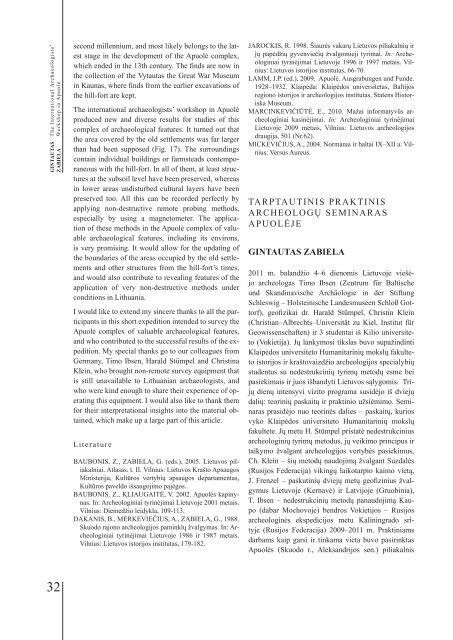BALTICA17 - KlaipÄdos universitetas
BALTICA17 - KlaipÄdos universitetas
BALTICA17 - KlaipÄdos universitetas
You also want an ePaper? Increase the reach of your titles
YUMPU automatically turns print PDFs into web optimized ePapers that Google loves.
The International Archaeologists’<br />
Workshop in Apuolė<br />
GINTAUTAS<br />
ZABIELA<br />
second millennium, and most likely belongs to the latest<br />
stage in the development of the Apuolė complex,<br />
which ended in the 13th century. The finds are now in<br />
the collection of the Vytautas the Great War Museum<br />
in Kaunas, where finds from the earlier excavations of<br />
the hill-fort are kept.<br />
The international archaeologists’ workshop in Apuolė<br />
produced new and diverse results for studies of this<br />
complex of archaeological features. It turned out that<br />
the area covered by the old settlements was far larger<br />
than had been supposed (Fig. 17). The surroundings<br />
contain individual buildings or farmsteads contemporaneous<br />
with the hill-fort. In all of them, at least structures<br />
at the subsoil level have been preserved, whereas<br />
in lower areas undisturbed cultural layers have been<br />
preserved too. All this can be recorded perfectly by<br />
applying non-destructive remote probing methods,<br />
especially by using a magnetometer. The application<br />
of these methods in the Apuolė complex of valuable<br />
archaeological features, including its environs,<br />
is very promising. It would allow for the updating of<br />
the boundaries of the areas occupied by the old settlements<br />
and other structures from the hill-fort’s times,<br />
and would also contribute to revealing features of the<br />
application of very non-destructive methods under<br />
conditions in Lithuania.<br />
I would like to extend my sincere thanks to all the participants<br />
in this short expedition intended to survey the<br />
Apuolė complex of valuable archaeological features,<br />
and who contributed to the successful results of the expedition.<br />
My special thanks go to our colleagues from<br />
Germany, Timo Ibsen, Harald Stümpel and Christina<br />
Klein, who brought non-remote survey equipment that<br />
is still unavailable to Lithuanian archaeologists, and<br />
who were kind enough to share their experience of operating<br />
this equipment. I would also like to thank them<br />
for their interpretational insights into the material obtained,<br />
which make up a large part of this article.<br />
Literature<br />
BAUBONIS, Z., ZABIELA, G. (eds.), 2005. Lietuvos piliakalniai.<br />
Atlasas. t. II. Vilnius: Lietuvos Krašto Apsaugos<br />
Ministerija, Kultūros vertybių apsaugos departamentas,<br />
Kultūros paveldo išsaugojimo pajėgos..<br />
BAUBoNIS, Z., KLIAUGAITė, V. 2002. Apuolės kapinynas.<br />
In: Archeologiniai tyrinėjimai Lietuvoje 2001 metais.<br />
Vilnius: Diemedžio leidykla, 109-113.<br />
DAKANIS, B., MERKEVIEČIUS, A., ZABIELA, G., 1988.<br />
Skuodo rajono archeologijos paminklų žvalgymas. In: Archeologiniai<br />
tyrinėjimai Lietuvoje 1986 ir 1987 metais.<br />
Vilnius: Lietuvos istorijos institutas, 179-182.<br />
JARocKIS, R. 1998. Šiaurės vakarų Lietuvos piliakalnių ir<br />
jų papėdžių gyvenviečių žvalgomieji tyrimai. In: Archeologiniai<br />
tyrinėjimai Lietuvoje 1996 ir 1997 metais. Vilnius:<br />
Lietuvos istorijos institutas, 66-70.<br />
LAMM, J.P. (ed.), 2009. Apuolė. Ausgrabungen und Funde.<br />
1928–1932. Klaipėda: Klaipėdos <strong>universitetas</strong>, Baltijos<br />
regiono istorijos ir archeologijos institutas, Statens Historiska<br />
Museum.<br />
MARcINKEVIČIŪTė, E., 2010. Mažai informatyvūs archeologiniai<br />
kasinėjimai. In: Archeologiniai tyrinėjimai<br />
Lietuvoje 2009 metais, Vilnius: Lietuvos archeologijos<br />
draugija, 501 (Nr.62).<br />
MIcKEVIČIUS, A., 2004. Normanai ir baltai IX–XII a. Vilnius:<br />
Versus Aureus.<br />
TARPTAUTINIS PRAKTINIS<br />
ARcHEoLoGų SEMINARAS<br />
APUoLėJE<br />
GINTAUTAS ZABIELA<br />
2011 m. balandžio 4–6 dienomis Lietuvoje viešėjo<br />
archeologas Timo Ibsen (Zentrum für Baltische<br />
und Skandinavische Archäologie in der Stiftung<br />
Schleswig – Holsteinische Landesmuseen Schloß Gottorf),<br />
geofizikai dr. Harald Stümpel, christin Klein<br />
(Christian–Albrechts–Universität zu Kiel, Institut für<br />
Geowissenschaften) ir 3 studentai iš Kilio universiteto<br />
(Vokietija). Jų lankymosi tikslas buvo supažindinti<br />
Klaipėdos universiteto Humanitarinių mokslų fakulteto<br />
istorijos ir kraštovaizdžio archeologijos specialybių<br />
studentus su nedestrukcinių tyrimų metodų esme bei<br />
pasiekimais ir juos išbandyti Lietuvos sąlygomis. Trijų<br />
dienų intensyvi vizito programa susidėjo iš dviejų<br />
dalių: teorinių paskaitų ir praktinio užsiėmimo. Seminaras<br />
prasidėjo nuo teorinės dalies – paskaitų, kurios<br />
vyko Klaipėdos universiteto Humanitarinių mokslų<br />
fakultete. Jų metu H. Stümpel pristatė nedestrukcinius<br />
archeologinių tyrimų metodus, jų veikimo principus ir<br />
taikymo žvalgant archeologijos vertybės pasiekimus,<br />
ch. Klein – šių metodų naudojimą žvalgant Suzdalės<br />
(Rusijos Federacija) vikingų laikotarpio kaimo vietą,<br />
J. Frenzel – paskutinių dviejų metų geofizinius žvalgymus<br />
Lietuvoje (Kernavė) ir Latvijoje (Gruobinia),<br />
T. Ibsen – nedestrukcinių metodų panaudojimą Kaupo<br />
(dabar Mochovoje) bendros Vokietijos – Rusijos<br />
archeologinės ekspedicijos metu Kaliningrado srityje<br />
(Rusijos Federacija) 2009–2011 m. Praktiniams<br />
darbams kaip garsi ir tinkama vieta buvo pasirinktas<br />
Apuolės (Skuodo r., Aleksandrijos sen.) piliakalnis<br />
32

















